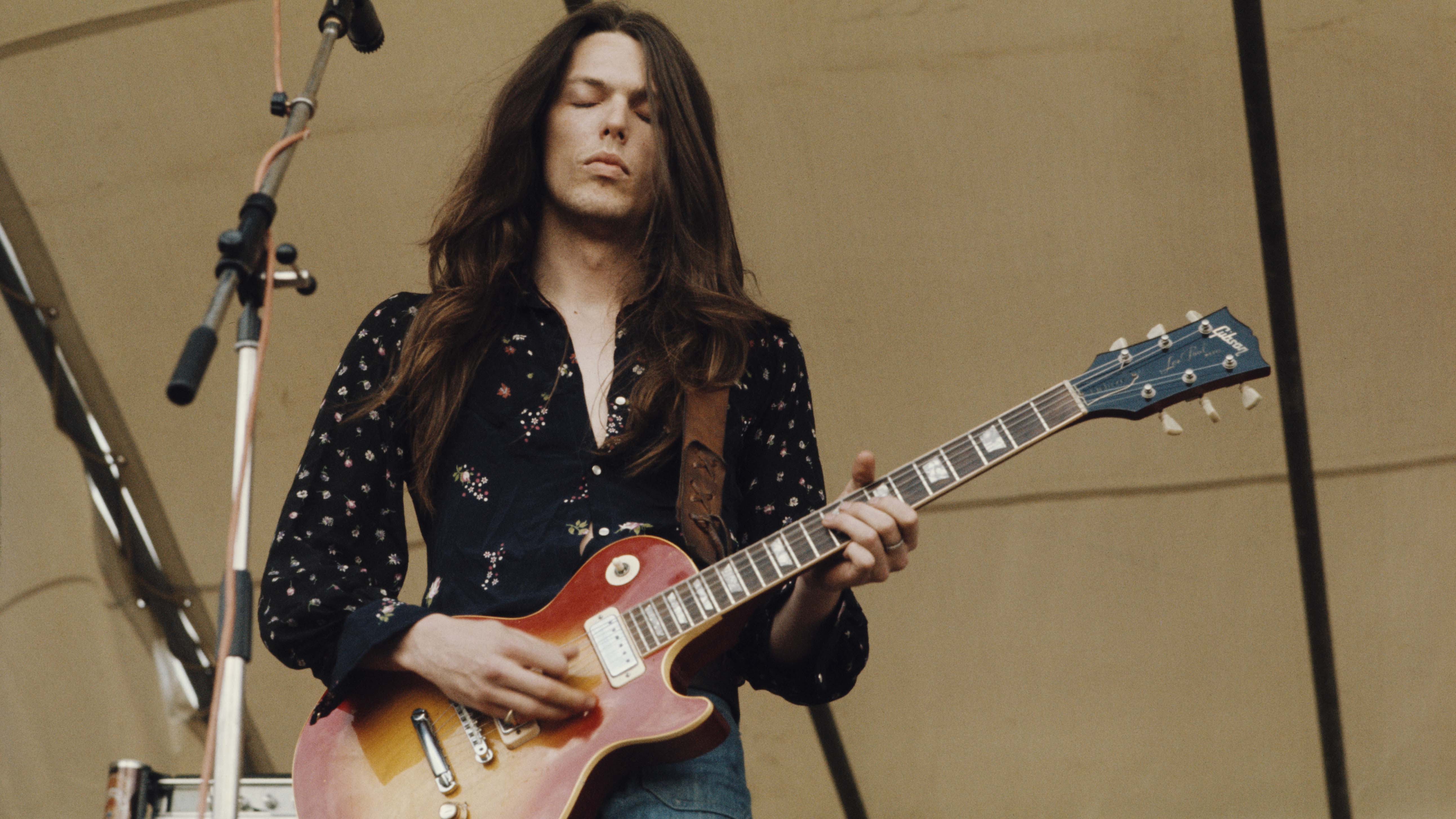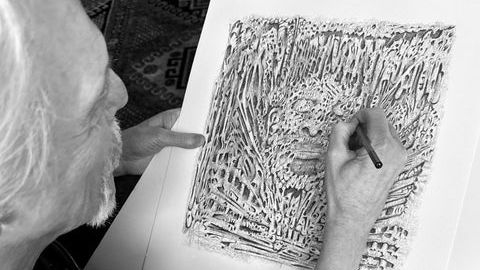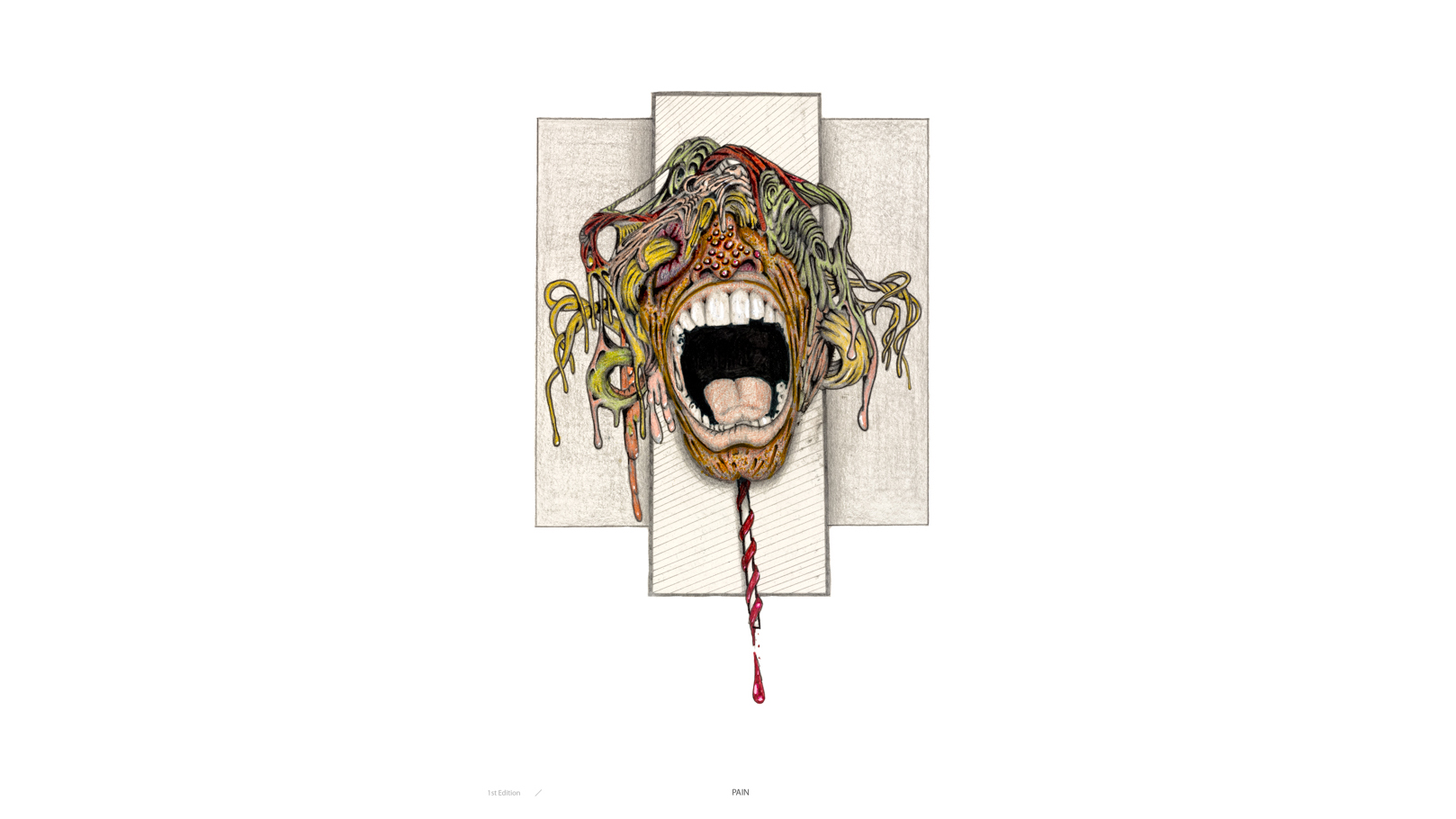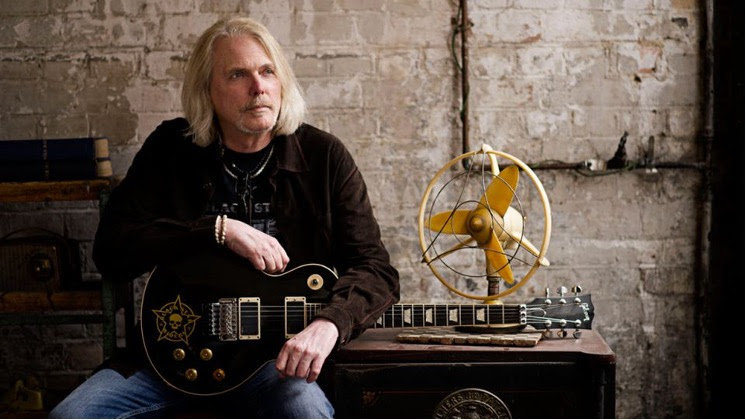"I've been doing this since like the mid-'70s and I never showed anybody: Scott Gorham on revealing his hidden artistic talent and his new plans for the first Thin Lizzy song he ever wrote with Phil Lynott

After listening to Thin Lizzy's rich catalogue countless times, and what he went on to do with 21 Guns and Black Star Riders, we thought we had a pretty good handle on Scott Gorham the musician. But there's a whole other side to his artistry he's kept secret for decades.
The newly-launched website Scott Gorham World showcases the first six illustrative works from an archive the Californian started creating under the radar as an artist nearly 40 years ago, with prints now available to purchase.
Scott originally drew these pieces for the sheer love of doing it, and without any intention of the world seeing him – even his wife didn't know he could draw. So we wanted to know more about the story behind his passion project, and also what's next for his playing with Thin Lizzy.

You've been a secret artist all these years, but what convinced you to finally go public with your art?
"I've been doing this since like the mid '70s – drawing – and I never showed anybody. I didn't show anybody in the band. In fact, I never even showed my wife. She didn't even know I did this.
My response was, 'No, no, no – this is just for me. I just do this on the side. I have fun with it – I don't need to show this off to anybody'
"I showed her one picture one day, and she went, 'Wow, that's that's really great, who gave you this?' And said, 'I did this', and she couldn't believe it. So she wanted to see the rest of them. And I reluctantly showed her the rest. She said that I really had to do something with them. But my response was, 'No, no, no – this is just for me. I just do this on the side. I have fun with it – I don't need to show this off to anybody.
"But she did that for three and a half years, trying to talk me into doing what we're doing right now. It had gotten to the point that every time she would mention it I would get up and walk out of the room. There was no conversation. But I wanted to see what they looked like blown up – I originally had no idea you could do that. So I took it over to a photographer friend of mine. A well respected guy called Denis O'Regan – a famous rock photographer who's been on tour with us, The Who and everybody. And I showed them to him. And he said the same thing as my wife: 'You've got to do something with this'.
Get the MusicRadar Newsletter
Want all the hottest music and gear news, reviews, deals, features and more, direct to your inbox? Sign up here.
"So I'm thinking, here's a guy that I know. Your wife is supposed to say those kinds of things to you, right? Because she loves you bla bla bla. But when you hear from a guy like Dennis O'Regan… oh, well okay, I'll start to think about this. And we blew one up and it looked really cool. And somebody else came in and saw it and was saying the same thing. So my confidence started to grow a bit about letting go and letting other people see it."
Was drawing your own private space in a way?
"Yeah, it was, you know. It was something that I didn't have to share with anybody. I wasn't gonna get criticised for it. But, I mean, there were no critics around – 'That nose isn't quite right'. So I just kind of avoided all of that.
"Because I still loved doing it, I thought that maybe if I got a couple of bad knockbacks, I'd stop doing it. And I don't want to stop doing it. So I shied away from putting any of this thing into the public sphere."
Jim Fitzpatrick illustrated a lot of Thin Lizzy's classic album covers, and he's a fan of your work too, is that right?
"Yes, I was blown away with that. Because I love Jim Fitzpatrick's work. I mean, he did nall of our album covers. And I will always remember the days when we were told that Jim Fitzpatrick was coming down and he's got the drawing – or the makings of the drawings of the next album, I just couldn't wait for those days to come. I loved everything that he did.
"He's an amazing guy, where all you had to do is give him a title or the line in a song and he'd say, 'Yeah, I think I can work with that'. And sure enough, he'd come back and it's just this great drawing, seemingly out of nowhere. And he did that multiple times. And I was so impressed with that, but it's why when I finally showed Jim, I was so nervous about what he was going to say.
"He was saying, 'Oh my God, there's a couple of here that really should have been album covers.' And I said, 'What?! Well not that Thin Lizzy ones because you're the man for that'.But he was very complimentary, and just felt really humbled with him giving me these kinds of compliments. I love the man to death."
There's several drawings that are because of the situations that I was in, or things that I had gone through
When you look back at the work in this collection, can you still pinpoint the times in your life when you created different pieces, maybe even the feelings that you were going through at the time?
"There's several that are because of the situations that I was in, or things that I had gone through. There's one that's just called Pain. And it's this guy, who undoubtedly is me. But I was going through a really terrible thing. They're, they're called cluster headaches and when I first started to get them, I thought, Oh, my God, do I have a brain tumour or brain cancer or something? The pain was just unbelievable.
"I went down to the doctor, the specialist, and he told me what they were. And I said, 'Well, this is gonna be kind of a problem here, you know, because if I get these headaches, they last for like, three weeks at a time, I'm in a dark room the whole time. I can't talk to anybody. I mean, if I'm out in the middle of God knows were on tour, there's no way that I could play guitar or any of that.'
I didn't understand why these headaches didn't hit me while I'm out on the road. And the doctor said something pretty amazing. He said, 'You know, the brain is a really amazing machine. It knows when it has to put a protective shell around you, and it will cut the pain out. But as soon as you come home, the brain will go, Okay, I'm in relaxed mode, the shell will come off, and then it gets you'.
"That actually makes sense. I mean, as horrible as that is, it did make sense. Those headaches really left an impression on me big time. So I went ahead and drew the Pain picture."

You only took one semester in art at the age of 14, but did the teacher notice that you had a natural ability as an artist?
"I don't know, because the semester before I took typing, and I thought, Okay, I've got all that down –I'm not going to be a secretary but I know how to type now. Well, what else do I want to try? And there's about five or six different things and there was this art class. I thought, I'll go down and talk with the teacher and I'll admit, she was blonde as she looked good. And I don't know if that was the reason why I wanted to go but she said, 'Okay, well, I'll give you a test – take a family member and draw a portrait, and then bring it back to me tomorrow and I'll judge it'.
"So I did. I asked my sister to sit in front of me and I drew. And the teacher looked at it, and she was like, 'Okay I'd love to have you in the class'. That same teacher, she would give us projects to do – 'Draw that building over there, I need to see perspective.' That kind of thing. So I'd be drawing away, and she would sneak around behind me and whip my paper up and go, 'Now, class, this is what I'm talking about'.
"The other people in the class were mostly girls. They were looking at me [angrily] thinking, 'Mine's way better'. And the teacher actually used to do it so often that when I'd see her come around, I would put my arm over whatever I working on to make sure that she couldn't grab it from me. Because I didn't want to be embarrassed anymore."
Is sounds like she recognised your talent.
"I guess she did, or I just kind of got what the lesson of the day was."
I think there's a lot of people out there who have this in them, that can probably maybe not easily do it, but can learn to do it and find a lot of fun with it
Do you think a lot of people out there have artistic talent but convince themselves they're not 'artists' because of a lack of confidence?
"You hit it right on the head there – it's a confidence thing. And the more you do it, the better you get at it, obviously. It's like playing guitar – the more you play guitar, the better musician you're going to become.
"To start out, you just have to keep probably knowing that the first few drawings are not going to be all that great. But then you're going to find yourself in a really cool groove and you learn how to shade this and create a perspective there.
"So it takes practice, but I think you're right, I think there's a lot of people out there who have this in them, that can probably maybe not easily do it, but can learn to do it and find a lot of fun with it."
Your story and art might inspire others too
"That would be great if this what I'm doing right now could actually inspire people to go out and say, 'Well, if that slob can do it I could do it', and I hope it does. I hope it does inspire somebody, even if it's just one person."

Did the other guys in Lizzy ever see your artwork?
"No, you gotta remember that I would start these drawings out on the road, right? I never finished them [on tour]. There's a lot of detail in the things in the things that I do. And I really couldn't get into that kind of detail out on the road.
"So knowing that, it was just kind of the bulk of the picture that I had, the outline, and to show everybody that… why show them that, I've got to show the finished product but I never brought any finished things out on the road."
Is outlining the concept and then adding detail afterward still your process with drawing?
"Very much. And sometimes it's not even an idea you know, I'll just just kind of freewheel and drawing abstract kind of things and I can see a figure in there or a building or a tower or something and I can I can build on that.
"Everything doesn't doesn't necessarily have to have a story. It's good to have an imagination. Landscape Artist Of The Year is completely opposite from what I'm doing. I still recognise how talented those people are but it there's kind of no story for them. You know you're looking at a tree and the tree doesn't really have a story. Your job is to make that tree look as real as possible or that building or that car whatever, right?
"My [approach] is more that I have to make up stories in my head to keep me going – to keep the story going and keep the pencil going. And there are times where you'll make that one line different and you go, 'Oh I've ruined the whole thing'. Then you think. Oh, it's actually okay. Because I can fix it, I can do [something else] and now the story changes. So I kind of cheat like that but it keeps you going."

Some musicians struggle to transition from life on the road to being at home, as it helped to give you balance or is it an escape?
"People use that word a lot – 'escape'. I used drugs for that, unfortunately. But no, drawing was never like an escape thing with me. My wife was always kind of wondering what I was doing up there for so many hours in that back room – I can't even imagine what she was thinking!
"I was never trying to escape from the guys in the band, because I really loved those guys. I loved hanging out with them. I've always loved being on tour, so playing on stage being on tour was kind of an escape in itself, right? But there are those times where you're out on the road for a couple or three months at a time and you're seeing the same faces every single day. And there are times where you just want to escape from the herd – 'I need to be by myself. I, I love you guys, but I can't hang out with you today, I'm gonna go do something else'.
I was just walking around by myself and I saw this art store
"I think that's what happened to me and Amsterdam in the the mid '70s. I was just walking around by myself and I saw this art store. The way they had it laid out just looked so cool and inviting. I just walked in with no intention of buying anything. And 30 minutes later, I had two pads of paper and shitload of pencils and erasers – all that. Okay, I better start doing something with it because I bought it. So maybe there was a subliminal thing going on there."
Halestorm's Lzzy Hale, Terrorvision's Tony Wright and yourself have also donated designs to Planet Rock for limited edition t-shirts in aid of a children's charity, is that right?
"Yes, I gave it to Planet Rock for the children's charity Cash For Kids. I really would urge everybody if you don't buy my design, buy one of them. Just because, you know, these are kids that need your help. They really do. They're poverty stricken kids are they've been brought up in in terrible circumstances. So in any way shape that I could have helped by giving them one of my drawings, I was more than happy to do that. So really, if everybody can go out there, just go to their website Planet Rock and just to see if you want to buy one of the t-shirts that'd be great.
There's a connection between illustration and Thin Lizzy because of the album covers you mentioned. Was seeing Jim Fitzpatrick's work an inspiration?
"It really was, seeing that he was the first artist, real artist that I really got to know. And I just thought that was so cool, man. Jere's a guy that can do something I can't do at all, at least I thought.
"Music is pretty much art too. Because it's coming from your own head, and you're making chord patterns, have you making riffs up, you're making lead lines up. It's the same thing as drawing – you're making that up, and that's going to look like that. So there's really a kind of an intertwining there of music and art, at least for me, the way I do it."
What's the status of Thin Lizzy now because I know that a couple of years ago you said that you wanted to focus on the band touring?
"There's always plans there. Right now. A couple of the mainstays of Thin Lizzy right are they're obligated to do a couple other tours. So I can't eat into that. Hopefully it will be either much later this year or sometime next year that we're going to bring it out and hopefully hit it really hard."
I had this riff and Phil looked up and asked, 'Is that yours?'
When you do, are there any songs that you haven't been able to revisit from from the back catalogue yet that you'd like to dust off?
"I'm glad you mentioned that, Rob. There is one. Well, there's probably several really, but there's one in particular, it's the the first song I ever wrote with Phil Lynott. It's a song called She Knows. And the way that came about was we were trying to write for the very first album [I appeared on] Nightlife. During the break, at some point, I had this riff [hums riff to She Knbows] and Phil looked up and asked, 'Is that yours?' I said yeah and he asked if I had any more to that – 'Yeah, as a matter of fact I do'. I played him what I thought was going to be the chorus, and I had a bridge to it. The whole time he was nodding going, 'Hey, do you mind if I write some lyrics to that?' Hell no man, bring it on!
"That was a great thing for me because I always thought Phil was a great songwriter, and now I'm getting a chance to work shoulder to shoulder with him on that first song, and then it became another song and another song and I really got into it. Especially on those first three albums, I really got into the writing side. I think I let the lead guitarist thing fall by the wayside a bit because I was really focused. I really wanted to write the songs.
"With She knows, I went to Universal Records [recently] and I said there's this song and I would love to get in there and remix it. Put a lot of percussion in there, man, maybe some kind of keyboard somewhere – stabbing organs and all that. And they said, 'Absolutely, we'll try to work out in the budget, and we'll try to make that happen'. So hopefully that will be my next Thin Lizzy project; getting a couple of these songs that maybe in the past, that I didn't think they were given a chance. And I would love to get in there and give a couple of those songs a lift and a bigger chance at it."

One thing that always stands out with your writing and playing approach is that you're a groove-orientated player, and that must have been such a great partnership with Phil on the bass side.
"Absolutely. He and I syncopated really well together, and with Brian Downey, it was like a cool little triumvirate thing we had going on there. They used to call it the happy high hands, because I was pretty good at getting the funk thing going. Phil loved that, and so did Downey.
"We wrote a few of the – and I know it's an old-fashioned term – but we wrote a couple of funk-type of songs that were actually pretty cool. Then there were other sections that just had the funk thing and then they turned into more rock things. So there was a lot of nice blending going on there. Whether the production helped us out [on record]… that's kind of another subject matter altogether so we won't go there!"
- Find out more about Scott Gorham's artwork at www.scottgorhamworld.com

Rob is the Reviews Editor for GuitarWorld.com and MusicRadar guitars, so spends most of his waking hours (and beyond) thinking about and trying the latest gear while making sure our reviews team is giving you thorough and honest tests of it. He's worked for guitar mags and sites as a writer and editor for nearly 20 years but still winces at the thought of restringing anything with a Floyd Rose.
“I’m beyond excited to introduce the next evolution of the MT15”: PRS announces refresh of tube amp lineup with the all-new Archon Classic and a high-gain power-up for the Mark Tremonti lunchbox head
“These guitars travel around the world and they need to be road ready”: Jackson gives Misha Mansoor’s Juggernaut a new lick of paint, an ebony fingerboard and upgrades to stainless steel frets in signature model refresh









